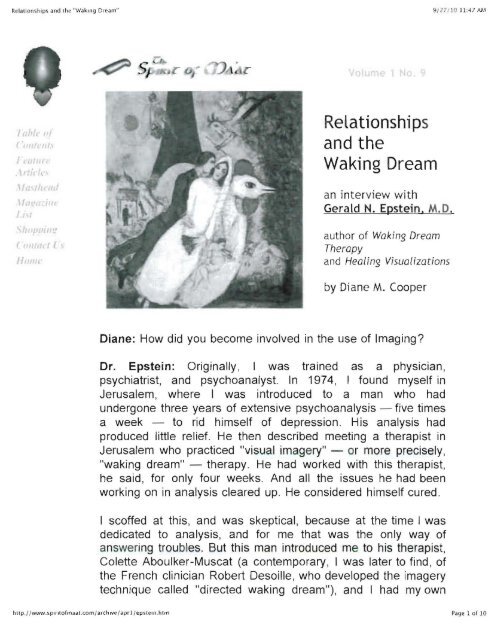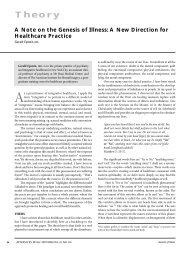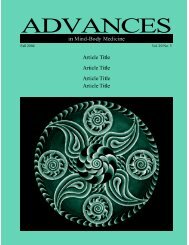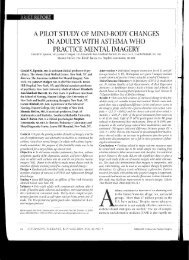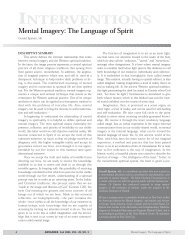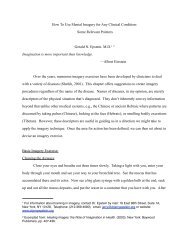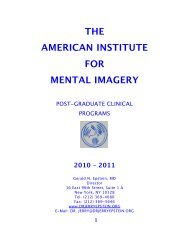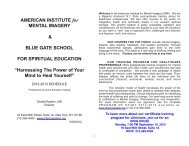spirit of maat april 2010 interview with Gerald ... - dr. jerry epstein
spirit of maat april 2010 interview with Gerald ... - dr. jerry epstein
spirit of maat april 2010 interview with Gerald ... - dr. jerry epstein
Create successful ePaper yourself
Turn your PDF publications into a flip-book with our unique Google optimized e-Paper software.
Relationships and Ihe "Waking Dream"9127110 J 1:4 7 AMRelationshi psI lIIr/. , J( ",hllh and the1,llIltl'Waking Dream.\rtitlt" ,fir adI1tl' -'I/t[,H(till''''' { ,/Ifill/Ian <strong>interview</strong> <strong>with</strong><strong>Gerald</strong> N. Epstein. M.D.author <strong>of</strong> Waking DreamTherapyand Healing Visualizationsby Diane M. CooperDiane: How did you become involved in the use <strong>of</strong> Imaging?Dr. Epstein: Originally , was trained as a physician,psychiatrist, and psychoanalyst. In 1974, I found myself inJerusalem, where I was introduced to a man who hadundergone three years <strong>of</strong> extensive psychoanalysis - five timesa week - to rid himself <strong>of</strong> depression. His analysis hadproduced little relief. He then described meeting a therapist inJerusalem who practiced "visual imagery" - or more precisely,"waking <strong>dr</strong>eam" - therapy. He had worked <strong>with</strong> this therapist,he said, for only four weeks. And all the issues he had beenworking on in analysis cleared up . He considered himself cured.I sc<strong>of</strong>fed at this, and was skeptical, because at the time I wasdedicated to analysis, and for me that was the only way <strong>of</strong>answering troubles. But this man introduced me to his therapist,Colette Aboulker-Muscat (a contemporary, I was later to find, <strong>of</strong>the French clinician Robert Desoilie, who developed the imagerytechnique called "directed waking <strong>dr</strong>eam"), and I had my ownhllp.IIW\WI. SPI (II <strong>of</strong><strong>maat</strong>.(om l arch Ive / apr 1/ epstelll. h 1m Page 1 o f ] 0
Re lat ionshIps and the "Wakmg Dream"9/27{lO 11.4 7 AMepiphany experience <strong>with</strong> her In the first few minutes <strong>of</strong> ourmeeting .Working <strong>with</strong> her changed the whole course and direction <strong>of</strong> mylife. I gave up psychiatry, conventional medicine, andpsychoanalysis, and went completely in this direction ,apprenticing <strong>with</strong> her for the next nine years. I learned the unity<strong>of</strong> mind and body, mental and physical, and the therapeutictechniques <strong>of</strong> waking-<strong>dr</strong>eam therapy, which enabled me to helpmy patients to directly ad<strong>dr</strong>ess and utilize the bodymind unity.Waking <strong>dr</strong>eam therapy is a deep, experiential journey <strong>of</strong> innerlife, using a person's night <strong>dr</strong>eams or daily conversation as thestarting point for waking exploration.Diane: How is this work applicable In the territory <strong>of</strong>relationships?Dr. Epstein: Relationships form a fundamental basis for th iswork, since most <strong>of</strong> the disturbances that we see are rooted insome disordered or disturbed relationship <strong>of</strong> one sort or another.Out <strong>of</strong> that comes the difficulties we face. Through experiencewe begin to understand how the body speaks and how it'srelating to these issues.Today, a man came to see me <strong>with</strong> a very unusual cancer thatexists in the space between his prostate and his colon. Heconnects it very clearly in his own mind in terms <strong>of</strong> his emotionalor inner turmoil and conflicts. He knows that it started four yearsago , when he found his wife in bed <strong>with</strong> another man. They hadpreviously been in a completely monogamous relationship. Thetrauma reverberated through him.In this work, we know that colonic disturbances have themeaning <strong>of</strong> extreme fury , rage, or hatred, and the prostate hasthe meaning <strong>of</strong> love - so he's in a self-acknowledged love-haterelationship <strong>with</strong> his wife .Diane: When you were in the early phase <strong>of</strong> this work , did youlearn by observing repetitive patterns?ho p: Il www . ~ J) . ru o fnlJ .l l CO m/.lr c htve / apr l i f p o; r c ill.htm Pag !;! 2 uf 10
Dr. Epstein: Yes. At the same time, it was helpful to know thecorrelation <strong>of</strong> the emotional life to the physical function <strong>of</strong> theorgans, such as the heart's being related to love. I also cameacross other people's research. For example, in my studies Idiscovered that in ancient Greek medicine the liver was noted asthe seat <strong>of</strong> anger. The Egyptians also spoke <strong>of</strong> the netterfunction. In the ancient pharaonic wisdom: "Form followsfunction. "Conventional medicine is based on Greek logical, rationaltraditions. Conventional training says we are able to seebecause we have eyes - "Form gives rise to function ." That isthe reverse <strong>of</strong> the <strong>spirit</strong>ual path, which says, "Function gives riseto form," or "Belief creates your experience." What you believe,you will manifest You know this yourself from your ownbackground. The inner gives birth to the outer.We don't smell because we have a nose - that is theconventional medical way. The possibility <strong>of</strong> smelling gives riseto the nose. The possibility <strong>of</strong> seeing, and the quality andfunction <strong>of</strong> seeing, give birth to the eyesI call this "revelatory medicine." You go inside to the innersources <strong>of</strong> knowledge to find what's necessary for yourself.We're born <strong>with</strong> this wisdom reposing <strong>with</strong>in us . The imagingwork gives access and the tools to get at this inner knowledge.You use yourself as your own healer. You become your owndoctor.Diane: In regard to personal relationships, many people arehaving difficulty <strong>with</strong>in their partnerships these days. How do youapproach this in terms <strong>of</strong> imagery and imagination?Dr. Epstein: First, we always look to keep the union, or to"make one." And we have two approaches. One is morphology,or face reading . We look at the faces <strong>of</strong> each partner, andthrough morphology we can come to understand the kind <strong>of</strong>person we are <strong>with</strong>. Then we don't have to take what the other isdoing personally. We can distance from the problem andhttp Ilw'WVII spirllormaal.coml arChive / apr I/ epstei n.htm Page 3 <strong>of</strong> 10
R('I Jtlonships and the "Wak ~ r\y Dream" 9/ 27/ 10 11 47 AMunderstand that our partner comes into the relationship <strong>with</strong>what he has been - what he was prior to the relationship.Knowing this allows a person to begin to find ways to deal <strong>with</strong>the particular morphology that he or she is married to.That has been <strong>of</strong> great success in my practice, because coupleswalking in <strong>with</strong> blame walk out <strong>with</strong> understanding and greaterresponsiveness <strong>with</strong> each other. That's one way to bring unionbetween two peopleThe second approach is experiential. We have a number <strong>of</strong>imaginal experiences that we use to help create union. We alsohave a particular exercise which allows us to see, through theuse <strong>of</strong> imagery, the exact state <strong>of</strong> the relationship The partiescan see exactly what is going on between the two <strong>of</strong> them, andthat then gives them a sense <strong>of</strong> reality about where they standand what the truth is <strong>of</strong> the situation.This may then provoke a decision. The decision may be to keepthe relationship going, or the decision may be to leave. But wecertainly look at first trying to find a way to keep the relationshiptogether.Diane: What about people who are single?Dr. Epstein: We give them a way to bring relationship into theirlives. We have a special exercise that allows them to do this.You can create your relationship. Remember, your belief createsyour experience. We also might look at what belief a personholds that stops the creation <strong>of</strong> a relationship . We not only deal<strong>with</strong> the disease symptoms that present themselves to us , butwe look to get to the source.Just yesterday, I was working <strong>with</strong> a client in his mid-fifties whohas always been single. He told me in a plaintive way, "Oh, Iwish I could have a relationship - I wish I could be married."But in getting to the root, we found that he lives a very indulgentpersonal life. He feels that he's completely free to come and goas he wants, buy for himself whatever he wants, sit in his
apartment surrounded by his favorite books, eat whatever hewants, indulge his gourmet tastes - he doesn't haveresponsibility to anyone or anything .So all the complaints are a smoke screen, and at the same timea statement <strong>of</strong> not wanting to give up his indulgent lifestyle,which is what he would have to do to be in relationship <strong>with</strong>someone. He would have responsibilities; he would have to careand nurture another, and compromise. He would have to rein insome <strong>of</strong> his impulses.So what disease does he get? What's the disease <strong>of</strong>indulgence?Diabetes.Because isn't diabetes the element that comes <strong>with</strong> the hyperingestion<strong>of</strong> sweets?Diane: Either that or lack <strong>of</strong> sweetness ...Dr. Epstein: Bitterness. Too much or not enough. You indulgeyourself <strong>with</strong> sweets, or your life is bitter and unfulfilled because<strong>of</strong> unattained goals or things you haven't acquired . Diabetes isthe physical ailment that can manifest as a result.At the root <strong>of</strong> this man's difficulty is this whole indulgence issuethat he has to contend <strong>with</strong> , plus the feeling about losing andtrading in "freedom" as he perceives it.Diane: Do you ever ad<strong>dr</strong>ess ch ildhood wounds?Dr. Epstein: No, we don't psychologize. We deal <strong>with</strong> what'scalled the phenomenology - the is-ness <strong>of</strong> what's presentingitself. Psychology to us is just another story that's been addedon to the belief systems we are already saddled <strong>with</strong> .It happens very <strong>of</strong>ten In the helping pr<strong>of</strong>essions thatexplanations pass as facts. We have created belief systemsabout what happened to us in the past, and we think that this ishltp.j /www. spiril<strong>of</strong>ma at. com/arch lve / aprl / epsleln .ht m Page 5 <strong>of</strong> 10
what has created what we are now. This is another example <strong>of</strong>"experience creates belief," which flies in the face <strong>of</strong> all <strong>spirit</strong>ualtradition.Experience does not create belief - it's the other way around ,as I was mentioning before. Belief creates experience. The innercreates the outer. And what's going on in your inner form <strong>of</strong>consciousness will manifest and reflect itself in the outer form <strong>of</strong>consciousness. That's my point <strong>of</strong> view.Diane: So what I'm hearing you say is that you look at what "is."And then you use a set <strong>of</strong> images that the subconscious mindwill "buy" to assist in making a shift?Dr. Epstein: With imaging, you create a new belief. Because it isimaging that mediates the belief to the experience.The image is sort <strong>of</strong> like the internal action - you do it on theinner form <strong>of</strong> consciousness first, and that gives us the impetus<strong>of</strong> doing it in the external form, which is the world in which welive.If you do it first in the inner, then that gives you the direction todo it in the outer. That's how we view it. That's one <strong>of</strong> thereasons imagery works.Diane: What can people do to assess their own relationshipsand take steps to resolve issues for themselves.Dr. Epstein: There is one major step to use, to see whether youare on track <strong>with</strong> your relationship And I think that would besufficient to start <strong>with</strong>.The question you ask is: "Do I feel more, or do I feel less?"For example, when you find yourself talking to your partner, thequestion you can ask yourself is, "Here I am <strong>with</strong> John. WithJohn, do I feel more, or do I feel less?That's the first self-evaluation as to where this relationshiphI [p: / fWINW. Spi ri to fm aat .com I arch Ive I ap r 1 i e pSle In. hIm Page 6 <strong>of</strong> 10
stands. If you're feeling less <strong>with</strong> someone, pay attention, even ifyou're giddy <strong>with</strong> the relationship and you think it's going verywell .Also, know that usually there are signs that are being given toyou which are being swept under the rug. Within the first week<strong>of</strong> a relationship, both parties put their cards on the table always. And usually one party, because they so desperatelywant the relationship, sweeps what they know under the rug .When this is done, it is guaranteed to come back and bite youon the foot. It's also a red flag . Be true to yourself. That's thekey. Don't lie to yourself. The signs are always there if there'ssomething amiss.Diane: Once the person determines the answers to those twoquestions, then what is the next course <strong>of</strong> action?Dr. Epstein: Don't depend on the other person for yourhappiness or well-being, or think that he or she has to change inorder to fulfill you .Diane: Let's talk about imagination. As a hypnotherapist, I'veworked extensively <strong>with</strong> the technique <strong>of</strong> regression therapy. Arethe images and stories that people connect <strong>with</strong> "real"?Dr. Epstein: Images are the language <strong>of</strong> truth. It's not a function<strong>of</strong> "real," it's a function <strong>of</strong> truth.Diane: But it's so easy to make things up.Dr. Epstein: Yes , you can fool yourself. But a true imageexperience is the language <strong>of</strong> truth - the invisible made visible.And the invisible always furnishes us <strong>with</strong> truth .Diane: Thanks, Dr. Jerry.Below are two exercises that Dr. Epstein suggests for increasingconnectedness in your primary relationship , or for ending arelationship to a specific person .hI tp: I / www. s pit ito frn aat.com / archlve / aprl/epsteio.htm Page 7 <strong>of</strong> 10
Two Healing Visualizations1. Blended Colors ExperiencePartners do this together every morning when they get up ,<strong>with</strong> the intention to bring closer their connection <strong>with</strong> eachother.Each person breathes out 3 times slowly. See the colorcoming out <strong>of</strong> your partner and see the color coming out <strong>of</strong>yourself. See the two colors blending , knowing that the two<strong>of</strong> you are becoming one.Breathe out and open your eyes.2. The Sands <strong>of</strong> TimeThis exercise is designed for help in ending a relationsh ip toa specific person . It is to be done twice - early morningand at twi light - twice a day for 7 days. It should takeabout 3 minutes each time.• Close your eyes and breathe out slowly three times.• See yourself walking along a beach holding hands <strong>with</strong>the one <strong>with</strong> whom you are ending . The two <strong>of</strong> you aredancing , skipping , and cavorting along the beach.• Then you <strong>dr</strong>op hands, say good-bye, and retrace yoursteps backward toward the shoreline. As you do,thoroughly clean out everything that you see beforeyou. See and sense your effort.• Finally, you reach the shoreline. The waves wash upon the beach , clearing away all the residue <strong>of</strong> therelationship that remains.http Ilwww.spin to fm aa t.comjarchlve/aprl (eps te in.hlm Pag e 8 <strong>of</strong> 10
• You then swim out to the horizon, using a regularoverhand or crawl stroke, seeing your arms and legsbecoming very long and your torso also elongating.Breathe in the pure air from the horizion.• Meet the horizon and come back to shore using abackstroke, your arms stretched out far behind yourhead, your legs stretched out far in front <strong>of</strong> you,kicking . Again, your torso is elongated . Keep breathingthe pure air from the horizion.• When reaching the shore, come out and let the sun <strong>dr</strong>yyou . Then, put on a clean robe or gown that you findthere, and return to your home.• Open your eyes.<strong>Gerald</strong> N. Epstein, MD, is the foremost practitioner <strong>of</strong>integrative medicine for healing and self-transformation.Trained as a Freudian analyst, he abandoned thisdirection in 1974 to study the therapeutic uses <strong>of</strong> theimagination under Madame Colette Aboulker-Muscat.Since then, he has been a pioneer in the use <strong>of</strong> mentalimagery for treating physical and emotional problems.As his work has evolved over the years, he has becomea leading exponent <strong>of</strong> the Western <strong>spirit</strong>ual tradition andits application to healing and therapeutics.In 1981, as a result <strong>of</strong> his clinical experiences, he wroteWaking Dream Therapy. Dr. Epstein has also authored:Healing Visualizations (1989), now considered theclassic book on the therapeutic use <strong>of</strong> mental imagery;hltP'; Iwww.splrilo fmaal.("o mjJ.rc hive/ aprl /epSlern.htm Page Y <strong>of</strong> 10


